Period 541 AD – 542 AD | ||
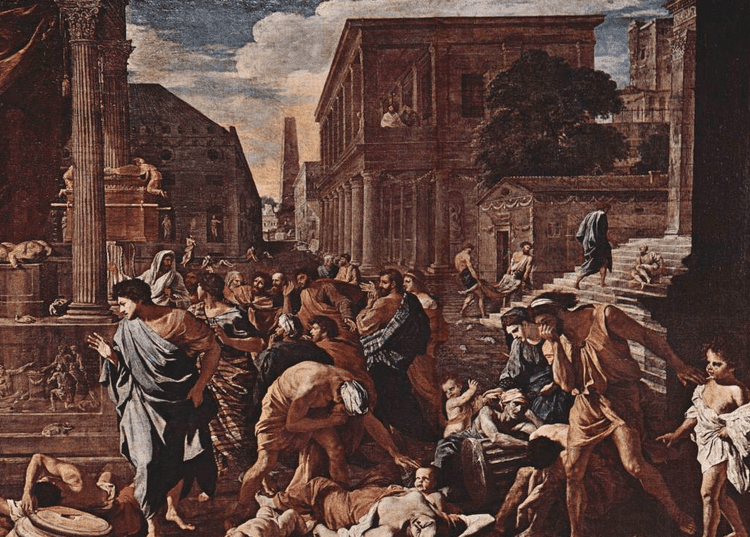 | ||
Similar Third plague pandemic, Black Death, Antonine Plague, Plague of Athens, Great Plague of London | ||
The plague of justinian i
The Plague of Justinian (541–542) was a pandemic that afflicted the Eastern Roman (Byzantine) Empire, especially its capital Constantinople, the Sassanid Empire, and port cities around the entire Mediterranean Sea. One of the deadliest plagues in history, this devastating pandemic resulted in the deaths of an estimated 25 million (at the time of the initial outbreak that was at least 13% of the world's population) to 50 million people (in two centuries of recurrence). Recent investigations relate this severe plague epidemic to extreme weather events of 535–536 considered as an example of volcanic winter.
Contents
- The plague of justinian i
- Dark ages the plague of justinian
- Cause
- Origins and spread
- Virulence and mortality rate
- References
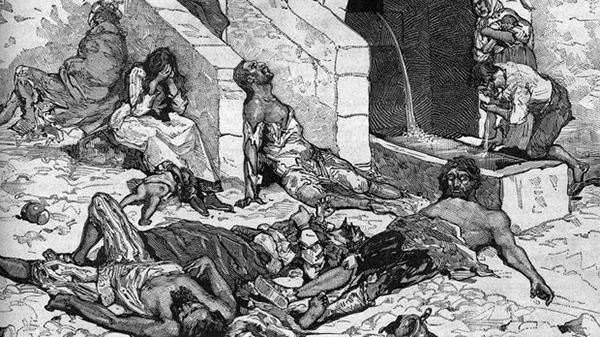
Recent research has confirmed that the cause of the pandemic was Yersinia pestis, the bacterium responsible for bubonic plague. The plague's social and cultural impact during the period of Justinian has been compared to that of the similar Black Death that devastated Europe 600 years after the last outbreak of Justinian plague. The principal historian during the 6th century, Procopius, viewed the pandemic as worldwide in scope. Genetic studies point to China as having been the primary source of the contagion.
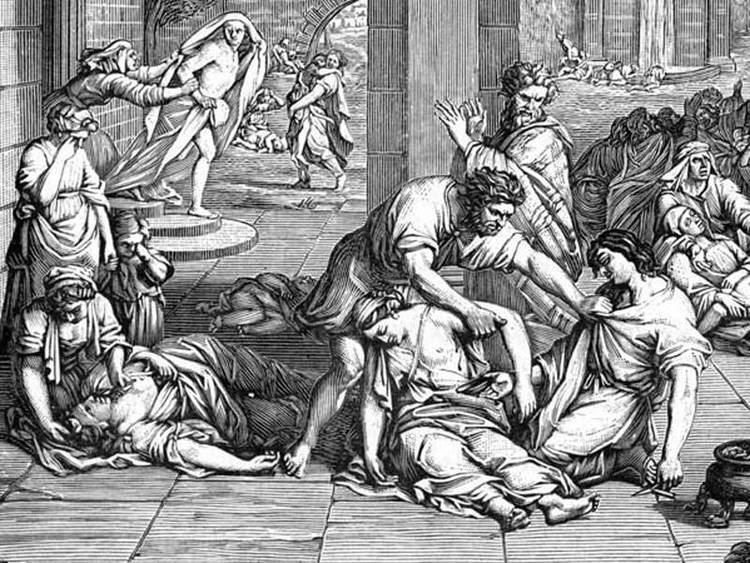
The plague returned periodically until the 8th century. The waves of disease had a major effect on the future course of European history. Modern historians named this plague incident after the Eastern Roman Emperor Justinian I, who was emperor at the time of the initial outbreak; he contracted the disease himself yet survived.
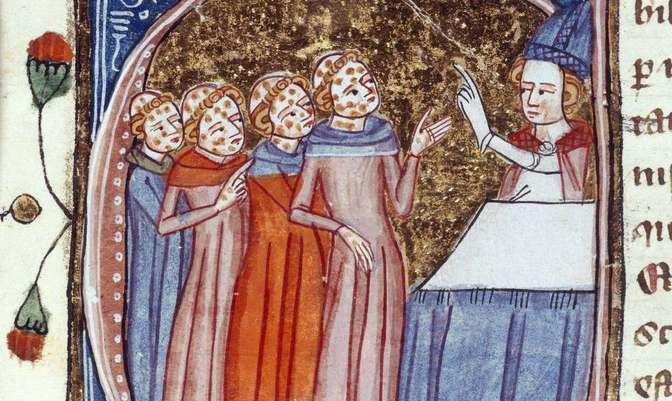
Dark ages the plague of justinian
Cause
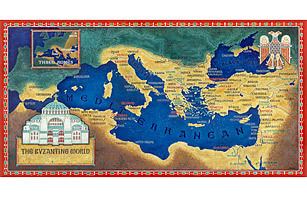
Recent investigations relate this severe plague epidemic to extreme weather events of 535–536, considered as an example of volcanic winter. The global climatic shift of this period, theorized as the Late Antique Little Ice Age, may have caused a disruption of ecology in human-populated environments, bringing the conditions for the pandemic.
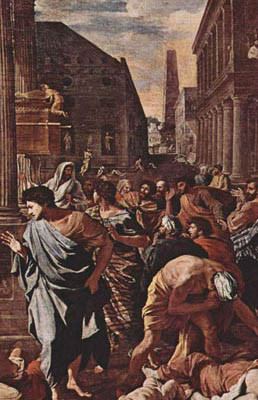
The Plague of Justinian is generally regarded as the first recorded instance of bubonic plague. This conclusion is based on the historical description of the clinical manifestations during the epidemic and the detection of Y. pestis DNA from human remains at ancient grave sites dated to that period. A genetic study of the bacterium causing bubonic plague based on samples taken from the remains of 14th-century plague victims in London and a survey of other samples suggests that the Plague of Justinian and others from antiquity arose from either now-extinct strains of Yersinia pestis genetically distinct from the 14th-century strain or came from pathogens entirely unrelated to bubonic plague. However, further work by the same researchers noted that the spread of several unusual modern variants of plague worldwide can be dated to an evolutionary radiation event approximately coinciding with the Plague of Justinian, supporting the notion that it was caused by a strain of bubonic plague.
Origins and spread
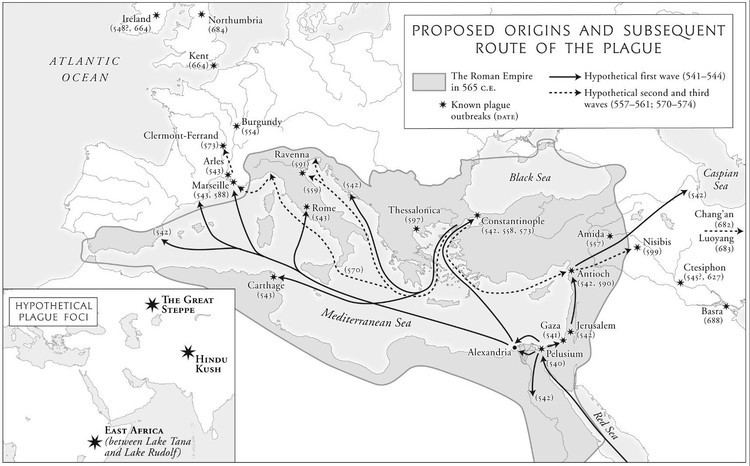
The outbreak in Constantinople was thought to have been carried to the city by infected rats on grain ships arriving from Egypt. To feed its citizens, the city and outlying communities imported massive amounts of grain, mostly from Egypt. Grain ships may have been the original source of contagion, as the rat (and flea) population in Egypt thrived on feeding from the large granaries maintained by the government. The Byzantine historian Procopius first reported the epidemic in 541 from the port of Pelusium, near Suez in Egypt. Two other firsthand reports of the plague's ravages were by the Syriac church historian John of Ephesus and Evagrius Scholasticus, who was a child in Antioch at the time and later became a church historian. Evagrius was afflicted with the buboes associated with the disease but survived. During the disease's four returns in his lifetime, he lost his wife, a daughter and her child, other children, most of his servants and people from his country estate.
Procopius, in a passage closely modeled on Thucydides, recorded that at its peak the plague was killing 10,000 people in Constantinople daily, but the accuracy of the figure is in question, and the true number will probably never be known. He noted that because there was no room to bury the dead, bodies were left stacked in the open. Funeral rites were often left unattended to, and the entire city smelled like the dead. In his Secret History, he records the devastation in the countryside and reports the ruthless response by the hard-pressed Justinian:
When pestilence swept through the whole known world and notably the Roman Empire, wiping out most of the farming community and of necessity leaving a trail of desolation in its wake, Justinian showed no mercy towards the ruined freeholders. Even then, he did not refrain from demanding the annual tax, not only the amount at which he assessed each individual, but also the amount for which his deceased neighbors were liable.
As a result of the plague in the countryside, farmers could not take care of crops and the price of grain rose at Constantinople. Justinian had expended huge amounts of money for wars against the Vandals in the region of Carthage and the Ostrogoths' kingdom in Italy. He had dedicated significant funds to the construction of great churches, such as Hagia Sophia. As the empire tried to fund the projects, the plague caused tax revenues to decline, possibly by the massive number of deaths and the disruption of agriculture and trade. Justinian swiftly enacted new legislation to deal more efficiently with the glut of inheritance suits being brought as a result of victims dying intestate.
The plague's long-term effects on European and Christian history may have been enormous. As the disease spread to port cities around the Mediterranean, the struggling Goths were reinvigorated and their conflict with Constantinople entered a new phase. The plague weakened the Byzantine Empire at a critical point, when Justinian's armies had nearly retaken all of Italy and the western Mediterranean coast; the evolving conquest would have reunited the core of the Western Roman Empire with the Eastern Roman Empire. Although the conquest occurred in 554, the reunification did not last long. In 568, the Lombards invaded Northern Italy, defeated the small Byzantine army that had been left behind, and established the Kingdom of the Lombards. The plague may have also contributed to the success of the Arabs a few generations later in the Byzantine-Arab Wars.
Some scholars have suggested that the plague facilitated the Anglo-Saxon conquest of Britain, as its aftermath coincided with the renewed Saxon offensives in the 550s, while the Saxons were contained. Maelgwn, king of Gwynedd in Wales, was said to have died of the "Yellow Plague of Rhos" around 547 and, from 548 to 549, plague devastated Ireland as well. Saxon sources from this period are silent, as there are no 6th-century English documents.
The Romano-British may have been disproportionately affected because of trade contacts with Gaul and other factors, such as British settlement patterns being more dispersive than English ones, which "could have served to facilitate plague transmission by the rat". The differential effects may have been exaggerated. British sources were then more likely to report natural disasters than Saxon ones. In addition, "the evidence for artifact trade between the British and the English" implies significant interaction and "just minimal interaction would surely have involved a high risk of plague transmission". However, scholars (like L. Lester in their Plague and the End of Antiquity: The Pandemic of 541–750), as evidence that the plague damage done on the Sub-Roman Britons was greater than the one suffered by the Anglo-Saxons, believe that the sudden disappearance around 560 AD of the important Roman town of Calleva was probably due to the Plague of Justinian, which later created a kind of curse on the city "damned" by the Anglo-Saxons.
Virulence and mortality rate
The number of deaths is uncertain. Modern scholars believe that the plague killed up to 5000 people per day in Constantinople at the peak of the pandemic. The initial plague ultimately killed perhaps 40% of the city's inhabitants and caused the deaths of up to a quarter of the human population of the Eastern Mediterranean. Frequent subsequent waves of the plague continued to strike throughout the 6th, 7th and 8th centuries, with the disease becoming more localized and less virulent.
This outbreak seems to have left a trace in the genome of Y. pestis itself.
After the last recurrence in 750, pandemics on the scale of Plague of Justinian did not appear again in Europe until the Black Death of the 14th century.
